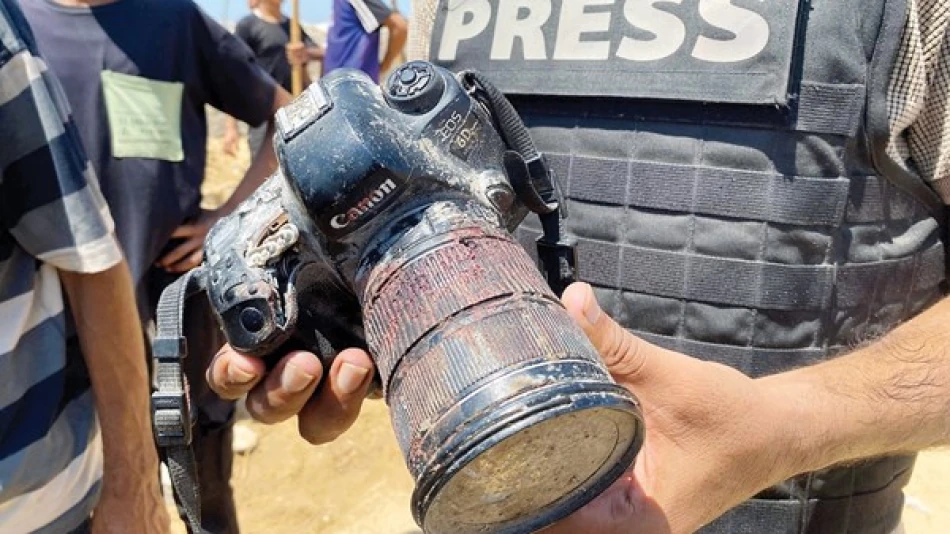
Gaza Tragedy: 20 Killed, Including 5 Journalists, in Israeli Airstrike on Hospital
Gaza's Healthcare System Collapses as Israeli Strikes Target Medical Complex, Killing Journalists and Aid Workers
Israel's bombing of the Nasser Medical Complex in southern Gaza has exposed the systematic destruction of the territory's healthcare infrastructure, killing at least 20 people including five journalists in what appears to be a coordinated assault on media operations. The strike, which targeted a Reuters broadcasting site within the hospital compound, represents a dangerous escalation in attacks on medical facilities and press coverage, while Gaza's health system reaches what WHO officials describe as a "catastrophic phase" with hospitals operating at 300% capacity.
Double-Tap Strike Pattern Emerges in Hospital Attack
The Israeli military's acknowledgment of the bombing comes after Palestinian health officials reported a calculated "double-tap" strike pattern at the Nasser Medical Complex in Khan Younis. The first airstrike killed Reuters contractor photographer Hussam al-Masri near a live broadcast site located just below the hospital's roof. When rescue workers and paramedics rushed to assist, a second strike killed additional journalists and first responders.
This tactical approach mirrors strike patterns documented in previous conflicts, where initial attacks are followed by secondary strikes targeting emergency responders. The Israeli military has announced an investigation into the incident, though such probes have historically yielded limited accountability.
Press Freedom Under Fire
The targeting of journalists operating from medical facilities raises critical questions about the protection of both press freedom and medical neutrality during armed conflict. International humanitarian law provides specific protections for hospitals and medical personnel, while journalists covering conflicts are considered civilians under the Geneva Conventions.
Famine Deaths Mount as Medical Crisis Deepens
Beyond the immediate casualties from strikes, Gaza's health authorities reported 11 additional deaths from malnutrition and famine-related causes within 24 hours, bringing the total famine-related death toll to 300, including 117 children. This systematic deterioration reflects what health officials characterize as a deliberate starvation policy.
The World Health Organization's representative in the Palestinian territories, Rick Peeperkorn, revealed that Gaza's healthcare system has reached unprecedented breaking points. Hospital bed occupancy rates have soared beyond any sustainable capacity: Al-Shifa Hospital operates at 240% capacity, Al-Rantisi at 210%, Nasser at 180%, and the National Hospital at 300%.
Critical Supply Shortages Paralyze Treatment
Medical supply chains have effectively collapsed, with 52% of essential medications and 68% of medical consumables completely depleted. Critical treatments including intravenous immunoglobulin and plasma exchange procedures are entirely unavailable, while hospitals struggle with severe blood and plasma shortages.
Only half of Gaza's hospitals remain partially functional, alongside 38% of primary care centers. This represents a healthcare infrastructure that has been systematically degraded beyond its ability to serve a population of 2.3 million people.
Bureaucratic Barriers Block International Medical Aid
International medical assistance faces mounting obstacles, with rejection rates for medical teams seeking entry to Gaza increasing by 50% since March. Israeli authorities have prevented 102 specialized medical personnel from entering the territory, including surgeons and specialists in critical fields.
Essential medical equipment continues to be blocked at border crossings, including anesthesia machines, intensive care beds, and cold-chain medications. These restrictions compound the crisis by preventing both immediate treatment capabilities and long-term medical infrastructure restoration.
Evacuation Orders Threaten Remaining Medical Services
Recent evacuation orders directly threaten the few remaining functional medical facilities. WHO's warehouse in Gaza City now falls within a newly designated evacuation zone, echoing the destruction of the organization's main southern warehouse. Three hospitals, one field hospital, an ambulance center, six primary care facilities, and two medical points operate within one kilometer of the evacuation zone.
Public Health Crisis Reaches Critical Mass
The convergence of infrastructure collapse, overcrowded shelters, malnutrition, and compromised immunity creates conditions for widespread disease outbreaks. Water and sanitation systems have failed across much of Gaza, while the population's weakened immune systems and limited access to preventive care amplify epidemic risks.
This systematic degradation of medical capacity, combined with restrictions on international aid and direct attacks on healthcare facilities, suggests a healthcare crisis that extends far beyond immediate war casualties. The targeting of medical infrastructure and personnel, whether intentional or through indiscriminate bombing, threatens to create long-term public health consequences that will persist well beyond any immediate ceasefire.
 Layla Al Mansoori
Layla Al Mansoori







